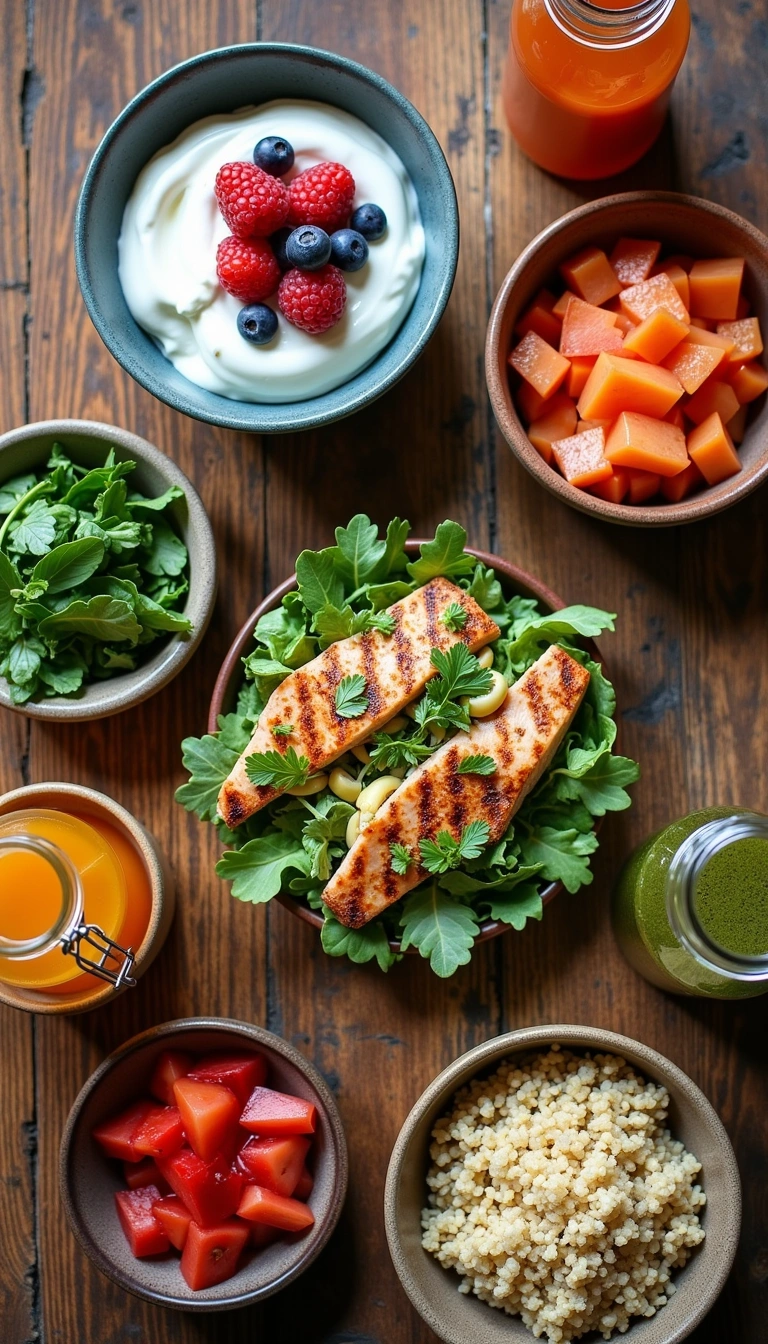A gut health diet meal plan can transform your digestive wellness faster than you might expect. Your stomach has been sending you signals that something needs to change. Those uncomfortable bloating episodes and energy crashes aren’t just random occurrences. It’s time to give your gut the nourishment it’s been craving all along.
Why Your Gut Needs This Meal Plan Right Now

Your digestive system is home to trillions of bacteria that control everything from your mood to your immune system. When these tiny helpers aren’t getting the right fuel, your entire body suffers. You might notice brain fog, skin issues, or that afternoon energy crash that hits like a brick wall.
This meal plan focuses on feeding the good bacteria while starving the harmful ones. You’ll eat foods packed with prebiotics, probiotics, and fiber that your gut microbiome absolutely loves. The best part? You don’t need to completely overhaul your kitchen or spend hours cooking complicated recipes.
Within just a few days of following this plan, you’ll start feeling lighter and more energized. Your digestion will improve, and that uncomfortable bloating will become a thing of the past. Let’s dive into exactly what you’ll be eating to make this transformation happen.
Your 7-Day Gut Health Transformation Menu
This weekly meal plan takes the guesswork out of gut-healthy eating. Each day includes three satisfying meals plus two gut-supporting snacks. You’ll rotate through different probiotic-rich foods and prebiotic powerhouses to keep your microbiome diverse and thriving.
The meals are designed to be simple but delicious, using ingredients you can find at any grocery store. Most recipes take 20 minutes or less to prepare, making this plan perfect for busy schedules. You’ll also find easy prep tips to make your week even smoother.
Day 1: Kickstart Your Gut Reset
Breakfast: Greek yogurt parfait with mixed berries, ground flaxseed, and a drizzle of raw honey. The probiotics in yogurt team up with prebiotic fiber from berries to create the perfect gut-friendly morning meal.
Lunch: Quinoa salad with roasted vegetables, chickpeas, and tahini dressing. This fiber-rich combo feeds beneficial bacteria while keeping you satisfied for hours.
Dinner: Baked salmon with steamed broccoli and sweet potato. Omega-3 fatty acids reduce gut inflammation while the vegetables provide essential prebiotics.
Snacks: Apple slices with almond butter, and a small portion of sauerkraut with whole grain crackers. These mini-meals keep your gut bacteria well-fed throughout the day.
Day 2: Building Digestive Momentum
Breakfast: Overnight oats made with kefir, chia seeds, and sliced banana. This creamy breakfast delivers probiotics and soluble fiber that your gut will thank you for.
Lunch: Lentil soup with a side of kimchi and whole grain bread. The fermented vegetables add beneficial bacteria while lentils provide prebiotic fiber.
Dinner: Grilled chicken with roasted Brussels sprouts and brown rice. These cruciferous vegetables contain compounds that support healthy gut bacteria.
Snacks: Homemade trail mix with nuts and dried fruit, plus a small cup of bone broth. The collagen in bone broth helps heal and seal your gut lining.
Day 3: Maximizing Microbiome Diversity
Breakfast: Smoothie bowl with spinach, mango, yogurt, and topped with granola and coconut flakes. Green smoothies pack vegetables into your morning routine effortlessly.
Lunch: Black bean and avocado wrap with fermented salsa. Legumes feed good bacteria while fermented foods introduce new beneficial strains.
Dinner: Turkey meatballs with zucchini noodles and marinara sauce. This lighter dinner is easier to digest while still providing complete nutrition.
Snacks: Celery sticks with hummus, and a small serving of kombucha. These snacks maintain steady blood sugar while supporting gut health.
Day 4: Strengthening Your Gut Foundation
Breakfast: Vegetable omelet with spinach, mushrooms, and a side of whole grain toast. Eggs provide easy-to-digest protein while vegetables add fiber and nutrients.
Lunch: Buddha bowl with mixed greens, roasted chickpeas, cucumber, and yogurt-based dressing. This colorful meal provides diverse nutrients for different bacterial strains.
Dinner: Baked cod with asparagus and quinoa pilaf. Fish provides anti-inflammatory omega-3s while asparagus acts as a powerful prebiotic.
Snacks: Mixed berries with a handful of walnuts, and miso soup. These combinations provide antioxidants and probiotics in perfect harmony.
Day 5: Optimizing Digestive Function
Breakfast: Steel-cut oats with stewed apples, cinnamon, and chopped almonds. This warming breakfast provides soluble fiber that forms a gel-like substance, feeding beneficial bacteria.
Lunch: Mediterranean salad with olives, feta cheese, and olive oil dressing. The healthy fats help absorb fat-soluble vitamins while supporting gut barrier function.
Dinner: Slow-cooked beef stew with root vegetables and herbs. Long cooking breaks down tough fibers, making nutrients more bioavailable.
Snacks: Banana with sunflower seed butter, and a small portion of pickled vegetables. These provide quick energy plus beneficial bacteria.
Day 6: Reinforcing Healthy Habits
Breakfast: Chia seed pudding made with coconut milk and topped with fresh fruit. Chia seeds expand in your stomach, providing lasting satiety and omega-3 fatty acids.
Lunch: Grilled vegetable and goat cheese salad with balsamic vinaigrette. Goat cheese is easier to digest than cow’s milk products for many people.
Dinner: Herb-crusted pork tenderloin with roasted carrots and wild rice. This balanced meal provides complete proteins and complex carbohydrates.
Snacks: Roasted pumpkin seeds and a cup of herbal tea, plus yogurt with a sprinkle of probiotics powder. These support digestion and relaxation.
Day 7: Completing Your Gut Reset
Breakfast: Weekend pancakes made with almond flour and topped with Greek yogurt and berries. You can still enjoy treats while supporting your gut health.
Lunch: Leftover soup or salad from earlier in the week. This reduces food waste while maintaining your healthy momentum.
Dinner: Celebration meal of your choice, incorporating at least two gut-healthy elements you’ve learned to love this week.
Snacks: Your two favorite snack combinations from the week. By now, you’ll know which ones make you feel best.
Essential Gut-Healing Foods to Stock Up On
Your shopping list should include fermented foods like yogurt, kefir, sauerkraut, kimchi, and kombucha. These provide live beneficial bacteria that colonize your digestive system. Choose varieties with minimal added sugar and no artificial preservatives for maximum benefits.
Prebiotic-rich foods feed the good bacteria already living in your gut. Stock up on garlic, onions, leeks, asparagus, bananas, apples, and Jerusalem artichokes. These foods contain special fibers that human enzymes can’t break down, but gut bacteria love to feast on them.
Don’t forget fiber-rich whole grains, legumes, nuts, and seeds. These provide bulk to your stool and help toxins move through your system efficiently. Variety is key – aim for 30 different plant foods per week to maximize microbiome diversity.
Quick Meal Prep Tips for Gut Health Success
Spend Sunday afternoon preparing fermented vegetables, cooking grains in batches, and washing fresh produce. This front-loaded effort makes weekday meals effortless. Store everything in glass containers to maintain freshness and avoid plastic chemicals that can disrupt gut bacteria.
Prepare overnight oats, chia puddings, and smoothie ingredients in individual portions. These grab-and-go options prevent you from skipping meals or reaching for processed alternatives. Your gut thrives on consistent, regular meals rather than sporadic eating patterns.
Keep emergency gut-healthy snacks on hand for busy days. Pre-portioned nuts, cut vegetables with hummus, and homemade energy balls ensure you always have something nourishing within reach. This prevents the blood sugar spikes and crashes that can disrupt your digestive system.
Simple Food Swaps That Make a Big Difference
Replace regular pasta with zucchini noodles, spaghetti squash, or legume-based alternatives. These swaps reduce refined carbohydrates while adding fiber and nutrients. You’ll feel lighter after meals and avoid the energy crashes that come with heavy starches.
Choose raw honey or maple syrup instead of white sugar when you need sweetness. These natural alternatives contain trace minerals and don’t spike blood sugar as dramatically. Better yet, let the natural sweetness of fruits satisfy your sweet tooth most of the time.
Swap regular salt for sea salt or Himalayan pink salt, which contain beneficial minerals. Add herbs and spices liberally – many have antimicrobial properties that support healthy gut bacteria balance. Turmeric, ginger, and garlic are especially beneficial for digestive health.
Signs Your Gut Health Is Improving
Within the first week, you’ll likely notice less bloating and more regular bowel movements. Your energy levels will become more stable throughout the day, without those dramatic afternoon crashes. Sleep quality often improves as your gut produces neurotransmitters that affect your brain.
After two weeks, your skin may start looking clearer and more radiant. Many people notice improved mood and mental clarity as the gut-brain connection strengthens. Food cravings, especially for sugar and processed foods, typically diminish as your gut bacteria composition shifts.
Long-term benefits include stronger immune function, better nutrient absorption, and reduced inflammation throughout your body. You’ll find that you can enjoy occasional treats without major digestive upset, as your gut becomes more resilient and balanced.
Troubleshooting Common Challenges
If you experience increased gas or bloating initially, don’t panic – this is normal as your gut bacteria adjust to new foods. Start with smaller portions of high-fiber foods and gradually increase them. Drink plenty of water and consider adding digestive enzymes temporarily to ease the transition.
Some people find certain fermented foods too strong at first. Begin with milder options like yogurt before progressing to more potent choices like kimchi or kombucha. You can also start with smaller amounts and work your way up as your taste buds adapt.
If meal prep feels overwhelming, start with just preparing one component at a time. Maybe cook grains on Sunday, then add vegetable prep on Wednesday. Building habits gradually is more sustainable than trying to change everything at once.
Making This Meal Plan Work Long-Term
The key to lasting success is flexibility and gradual implementation. You don’t need to follow this meal plan perfectly to see benefits. Focus on incorporating more gut-healthy foods into your existing routine rather than completely overhauling your diet overnight.
Listen to your body and adjust portions and foods based on how you feel. Some people thrive on larger amounts of fermented foods, while others do better with more cooked vegetables. Your gut microbiome is unique, so your optimal diet will be too.
Build a support system by involving family members or friends in your gut health journey. Share meals, swap recipes, and celebrate improvements together. Having accountability partners makes healthy habits more enjoyable and sustainable over time.
Starting this gut health meal plan today sets you up for improved digestion, better energy, and overall wellness for years to come. Your future self will thank you for taking this important step toward optimal health.

Lifebing is driven by an unrelenting passion for promoting health and well-being, our team is wholly committed to curating exceptional content and immersive experiences.
